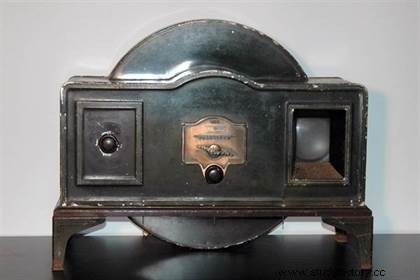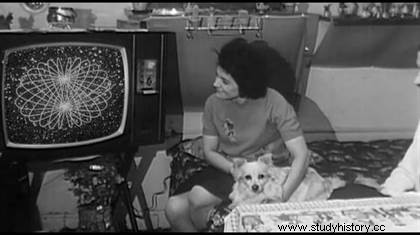 The Invention of Television is the culmination of a long journey of discoveries and inventions made from the end of the 19th century. January 26, 1926 sees the first public broadcast of television images by Scotsman John Logie Baird . Confidential and for a long time in black and white, the television set then experienced a dazzling development from the 1950s, gaining color and inviting itself into most homes. Daily media, TV saw its offer considerably redefined from the 2000s by widespread digitization, which did not spare this doyen of information and entertainment.
The Invention of Television is the culmination of a long journey of discoveries and inventions made from the end of the 19th century. January 26, 1926 sees the first public broadcast of television images by Scotsman John Logie Baird . Confidential and for a long time in black and white, the television set then experienced a dazzling development from the 1950s, gaining color and inviting itself into most homes. Daily media, TV saw its offer considerably redefined from the 2000s by widespread digitization, which did not spare this doyen of information and entertainment.
Invention of television
Among the Precursors Television, we can cite Willoughby Smith, who showed the photoconductivity of selenium in 1873. In 1880, the Frenchman Maurice Leblanc indicated the principles of television as we know it today. In order for moving images to be transmitted, in 1884 the German engineer Paul Nipkow produced the first fast scanning system (Nipkow's disk). This system of rotating discs was quickly perfected with the invention of the photoelectric cell by the Germans Julius Elster and Hans Geitel in 1889. Their compatriot Karl Ferdinand Braun developed a decisive invention, the cathode ray tube , in 1897. For his scientific work, he received the Nobel Prize in Physics in 1909.
 Following Baird's public demonstration in 1926, Russian-born American Vladimir Zworykin unveiled its kinescope where the cathode ray tube screen becomes the small television screen. This more modern and coherent device was adopted, in particular by the English company E.M.I., and operated by the BBC in 1936. It surpassed the Tele-visor, the first consumer television set, which Baird marketed without much success in 1930. The first receivers were marketed in the United States as early as 1941; color television will see the light of day there in 1953 (in Europe, at the beginning of the 1960s). Relay satellites provide long-distance transmissions.
Following Baird's public demonstration in 1926, Russian-born American Vladimir Zworykin unveiled its kinescope where the cathode ray tube screen becomes the small television screen. This more modern and coherent device was adopted, in particular by the English company E.M.I., and operated by the BBC in 1936. It surpassed the Tele-visor, the first consumer television set, which Baird marketed without much success in 1930. The first receivers were marketed in the United States as early as 1941; color television will see the light of day there in 1953 (in Europe, at the beginning of the 1960s). Relay satellites provide long-distance transmissions.
History of television
Although the development of television paused during the Second World War, electronic resources being mobilized for the military effort, it resumed as soon as the conflict was over. The electronics giant RCA (Radio Corporation of America) financed the first steps of television in the United States. At the start of the 1960s, 88% of American homes were equipped. The sector then represents 1.3 billion dollars annually in advertising.
 Although a transmitter was installed at the top of the Eiffel Tower as early as 1937 and a first report was broadcast live from the Universal Exhibition, the state monopoly on telecommunications is hampering the development of French television. The ORTF will long offer a limited number of channels and broadcast hours. Long perceived as the official voice of the government which invites itself every evening in the living rooms of the French, it will nevertheless broadcast very popular programs such as La piste aux étoiles or Five columns in the spotlight .
Although a transmitter was installed at the top of the Eiffel Tower as early as 1937 and a first report was broadcast live from the Universal Exhibition, the state monopoly on telecommunications is hampering the development of French television. The ORTF will long offer a limited number of channels and broadcast hours. Long perceived as the official voice of the government which invites itself every evening in the living rooms of the French, it will nevertheless broadcast very popular programs such as La piste aux étoiles or Five columns in the spotlight .
At the turn of the 1960s and 1970s, the history of television accelerated. On July 21, 1969, the live broadcast of the first steps on the Moon was an event watched by more than six hundred million viewers worldwide. This retransmission symbolizes the entry into the era of mass television. The appearance of new television channels opens the era of competition and the race for ratings. The needs of the audience then prevailed over the educational demands of the old monopoly and public service television.
 In the early 1980s, television acquired a little more independence with the creation of new regulatory bodies of the audiovisual landscape, responsible for ensuring the pluralism of the audiovisual press and freedom of expression. The channels are multiplying, first with the creation, in 1983, of Canal +, an encrypted pay channel. Then, in 1986, while the cable plan and negotiations on satellite broadcasting were relaunched, two commercial networks appeared:La Cinq and TV 6 (which became M6 in 1987). The same year, TF1, the largest and oldest of the channels, was privatized.
In the early 1980s, television acquired a little more independence with the creation of new regulatory bodies of the audiovisual landscape, responsible for ensuring the pluralism of the audiovisual press and freedom of expression. The channels are multiplying, first with the creation, in 1983, of Canal +, an encrypted pay channel. Then, in 1986, while the cable plan and negotiations on satellite broadcasting were relaunched, two commercial networks appeared:La Cinq and TV 6 (which became M6 in 1987). The same year, TF1, the largest and oldest of the channels, was privatized.
TV in the digital age
The opening up to the private sector in the mid-1980s breathed new life into the development of television with a larger offer, but not always of quality. Above all, it was the arrival and generalization of digital technology from 2005 with DTT and the Internet that profoundly upset the offer and modes of television consumption. On-demand TV around the heavyweight Netflix, founded in 1997, or even the popularization of the podcast for radio are redefining an offer that no longer has much in common with the consumption of streams at fixed times on which established the success of 20th century media landscapes.
The small screen, which has become increasingly larger and flatter over time, now faces competition from other media, such as the smartphone.
To go further
- The site of the National Audiovisual Institute.
- History of French television:From 1935 to the present day, by Monique Sauvage. Pocket History, 2014.
- The fabulous history of inventions - From mastery of fire to immortality. Dunod, 2018.
